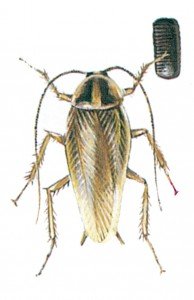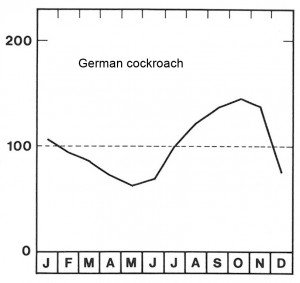

Latin: Blatella germanica.
This is the most common of the cockroaches that occur in connection with food in Northern European countries. It is approximately 12 mm long and have well-developed elytrons that cover the entire abdomen. The breast is yellowish brown with two dark stripes. Under the elytrons are quite well-developed flying wings. They are not used to fly, but is on rare occasions used as a kind of gliders when the cockroach jumps from tables and shelves onto the floor. Cockroaches are omnivorous, but you rarely find them in food. They are active when it is dark. When it is bright, they sit in cracks and crevices near furnaces, heating pipes, refrigerator motors and other places where they can find temperatures between 25 and 33 ° C, as they prefer.
Cockroaches are social insects. A substance that attracts and unifies them is secreted from glands in the intestine and released later from the excrement. Mating behaviour is also controlled by scent signals. The female secretes fragrances which in low concentration attract males, while higher concentrations of the same odorant triggers the mating game. These pheromones are used in some cockroach traps. Females lay their eggs in brown capsules. These capsules are divided into 30-40 small compartments, each containing an egg. The female carries around the capsule – sticking out of the vulva – until offspring begins to swarm out. Development is progressing through 6 -7 nymphal stages which are relatively wider and darker coloured than the adults. The small nymphs can hide in crevices, which are only 1.6 mm wide (a pregnant female needs 4.5 mm). The development takes about 2 months at 30 ° C, whereas it takes six months at 21 ° C.

German cockroaches are most comfortable in moist, warm areas with access to water. They climb well and can be found throughout the rooms from floor to ceiling. Dispersal of the cockroach is quite passive. The insects are transported around in goods or empty packaging. The voids in beer cases for example are good hiding places for cockroaches. Cockroaches can damage food by chewing them, by contaminating them with their droppings and by the unpleasant odour that cockroaches have. In addition, it is generally poor advertising that cockroaches come with a company’s goods.




